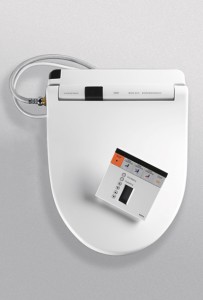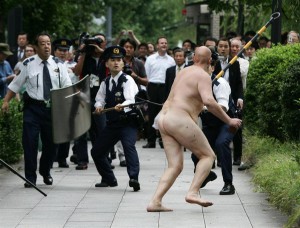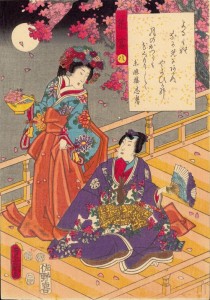 Toilets – The Japanese take pooping very seriously. How many people do you know in North America willing to spend $5,000 on a crapper? In Japan, that is quite common. The toilets are a bit different than the ones we have here. For instance their flusher has two settings, “small” (小) and “large” (大), which change amount of water used. Their toilets will frequently have a faucet at the back of the toilet for washing one’s hands. The grey water is then recycled as the water for the next flush. Obviously every eco-friendly.
Toilets – The Japanese take pooping very seriously. How many people do you know in North America willing to spend $5,000 on a crapper? In Japan, that is quite common. The toilets are a bit different than the ones we have here. For instance their flusher has two settings, “small” (小) and “large” (大), which change amount of water used. Their toilets will frequently have a faucet at the back of the toilet for washing one’s hands. The grey water is then recycled as the water for the next flush. Obviously every eco-friendly.
While the toilets are advanced, the seats are fucking space-aged. Many include wall mounted control panels with motion detectors that raise the seat when you walk in. The rest of the time the seat lid is closed to prevent animals from drinking from the toilet presumably. The seat is heated (a basic feature), starts a fan when you sit down as an air deodorizer, and if you are a lady will play music or splash water so people cannot hear you pee.
When you are ready, you push a button and a spout comes out and washes your bum with a temperature and force adjustable stream with a cycling movement and a massage feature. Another button will dry it.
I love these seats so much I bought one and brought it back to install in my bathroom going so far as to have a socket installed near the toilet to make it work!
Hanami – This is the very Japanesed tradition of viewing flowers (hana) in the park, particularly cherry blossoms. The best time to visit Japan for hanami is early-mid April. The blossoms are beginning to come out and people will fill the parks having picnics and drinking far too much. This is a very old tradition said to have been started in the Nara Period, 1300 years ago!
In Tokyo, corporations will actually hire people to camp out a few days before the cherry blossoms bloom to reserve their choice spots under the flowers. You can follow the blossoming progress from the South part of the island all the way to the North and is a topic of considerable conversation.
When I was in Japan a couple of years ago we went to a hanami in the park in Shinjuku. There were thousands of people sitting on blue tarps under the trees drinking copious amounts of Sake. a good time indeed!
Vending Machine Roulette – Vending machine roulette is a term coined by a friend working in Japan. In Japanese fast food restaurants you can get almost everything; tempura, ramen, katsudon, any typical soul food. The catch is unless you can read Japanese, you don’t know which button is which.
Most of the food is pretty inexpensive, so if you end up getting stinky fish or something you just try again. The funny thing is, it sort of makes sense. You keep the food handlers from handling filthy money, you ensure exact change is always given and in a unique Japanese fashion, prevents having to tell your customers you are out of something – the machine tells them.
 Gaijin Smash – another term coined by my friend. Gaijin smash is a term used to describe the stuff you can get away with in Japan simply for being a foreigner. I liken it to my “great white passport” I used in China. Essentially there are social norms, such as not talking on a cell phone on the subway, or not putting sugar in your green tea. These social norms can be bent by foreigners because, for lack of a better way to put it, we don’t know any better. Gaijin smash however includes the intentional breaking of social norms.
Gaijin Smash – another term coined by my friend. Gaijin smash is a term used to describe the stuff you can get away with in Japan simply for being a foreigner. I liken it to my “great white passport” I used in China. Essentially there are social norms, such as not talking on a cell phone on the subway, or not putting sugar in your green tea. These social norms can be bent by foreigners because, for lack of a better way to put it, we don’t know any better. Gaijin smash however includes the intentional breaking of social norms.
The subway system uses tickets, which you purchase from a machine. The ticket price is based on where you are and your destination. You place the ticket into the turnstile gate to enter, the ticket is spat out the other end of the gate with a hole punched in it. You need to grab this ticket again because you need it to get out of the subway again. If you forget to grab the ticket, or you loose the ticket you’re supposed to pay some fee. Being a foreigner you can get out of the subway by just walking out the gate and no one will question you. If you are feeling really bold, you could try just walking onto the subway, although that might get a little embarrassing if you get caught.
Or you might go swimming naking in the Imperial moat…
Bike Rules – Suprise! There are none! People ride their bikes with traffic, against traffic, on the street, on the sidewalk. Bikes are relatively cheap ($100-$200) but come with kick stands, automatic lighting for when it gets dark, and built in locks. What you will notice about the bikes is that everyone rides them – kids, grandparents, soccer moms, everyone. And you can park them almost everywhere.
No one wears a helmet and traffic signs are merely suggestions. The nice thing is, traffic in Tokyo is used to dealing with these erratic cyclists. Coming from a country with strict bike rules, and a city which is genuinely hostile to cyclists it is a joy to ride in a country which has such freedom. If you are headed to Japan, I highly recommend purchasing a bike.

